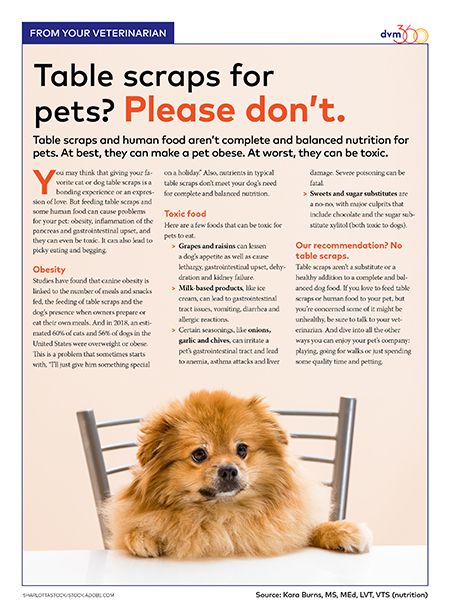Client handout: No to feeding pets table scraps
When it comes to advice for veterinary clients, I discourage feeding pets table scraps and human food. The pet obesity epidemic and the danger of toxicities mean I lean away from encouraging sharing of food to maintain the human-animal bond.

Sharlottastock/stock.adobe.com
For some veterinary clients, giving pets table scraps is a bonding experience. It's an expression of love. (And, let's be honest, some of us do it too.) But we veterinary professionals know that these actions may result in a variety of disease conditions: obesity, pancreatitis, gastrointestinal upset and toxicities. Through this behavior, pet owners are also reinforcing such behavioral issues as picky eating and begging.
Human food/table scrap toxicity examples
Veterinary clients should know about …
• Grapes and raisins. These can lead to inappetence, lethargy, GI upset, dehydration and kidney failure.
• Milk-based products. Milk, ice cream and others can lead to GI tract issues, vomiting and diarrhea and allergic reactions
• Seasonings. Onions, garlic and chives may irritate the GI tract and lead to hemolytic anemia, asthma attacks and liver damage. Hemolytic anemia impacts/destroys red blood cells. Severe poisoning can be fatal.
• Sweets and sugar substitutes. Chocolate can cause anxiety, vomiting, diarrhea, elevated heart rate, seizures and may lead to death. Xylitol, a sugar substitute, is toxic to pets. Even in small amounts, xylitol can cause dangerously low blood sugar levels, seizures, liver failure and possibly even death.
Let's start with weight. Canine obesity is linked with the number of meals and snacks fed, the feeding of table scraps and the dog's presence when its owners prepare or eat their own meal.1,2 In 2018, an estimated 60% of cats and 56% of dogs in the United States were overweight or obese.3 This is an epidemic that often starts with “I only give him something special on a holiday” and ends with daily table scraps.
What does this mean? Every pet needs a nutritional evaluation every time they're examined by the veterinary healthcare team. Part of this evaluation is a nutritional history, and part of that nutritional history centers around the feeding behaviors of the owners. One popular feeding behavior is the feeding of people food or table scraps to pets.
The practice of feeding table scraps and human foods to pets is well documented. One study found 25% of pet owners feed table scraps, and 85% feed human food. Pet owners admitting to feeding human food reported a variety, ranging from confectionary to fast food.4 Another study found that regardless of the body condition score of the dog, 59% received table scraps, which made up 21% of daily caloric intake. Additionally, the nutrients in the table scraps did not meet the National Research Council's recommendations for micronutrient adequacy.5
The bottom line: Table scraps are not healthy for pets. Not only do they contribute to obesity, but they're not complete and balanced, lead to begging and “picky eating,” and may be toxic to pets.
Table scraps should not be used as a substitute for a complete and balanced dog food. In addition, you should explain the benefits of other, healthier types of bonding experiences for the pet and the owner. Great experiences don't need to center around food. Playing, going for walks or simply petting the animal are fun and help both pet and owner strengthen the human-animal bond.
Veterinary team members should be calculating the amount to feed each patient based on the nutritional history, diagnosis, lifestyle and life stage of the patient. Table scraps are out. At best, the veterinary team should allow formulated treats for pets, again according to the individual pet. Remember, though, that treats should be limited to no more than 10% of a pet's total daily calories.
Want to explain some of this in a printable client handout? Click here or on the image below.

References
1. Lund E, Armstrong P, Kirk C, et al. Prevalence and risk factors for obesity in adult cats from private US veterinary practices. Intern J Appl Res Vet Med 2005;3:88–96.
2. Lund EM, Armstrong PJ, Kirk CA, et al. Prevalence and risk factors for obesity in adult dogs from private US veterinary practices. Intern J Appl Res Vet Med 2006;4:177–186.
3. Ward E. Association for Pet Obesity Prevention. https://petobesityprevention.org/ accessed June 7, 2019.
4. German AJ, Holden S, Gernon LJ, et al. Do feeding practices of obese dogs, before weight loss, affect the success of weight management? British Journal of Nutrition 2011;106:S97–S100.
5. Heuberger R, Wakshlag J. The relationship of feeding patterns and obesity in dogs. Journal of Animal Physiology and Animal Nutrition 2011;95:98–105
Kara Burns is a licensed veterinary technician with masters' degrees in physiology and counseling psychology and is a VTS in nutrition. She is the founder and president of the Academy of Veterinary Nutrition Technicians and is the current president of NAVTA. Kara teaches nutrition courses around the world and is an independent nutritional consultant as well as a consultant for the Lafeber Company and Emeraid. In her spare time, she enjoys collecting sports memorabilia (especially hockey items) and is a storm spotter for the National Weather Service. A superhero enthusiast, Kara has a Persian kitty named Oliver Queen (that's Green Arrow, people).